Albatrosses are iconic seabirds known for their impressive wingspans, effortless gliding, and ability to traverse vast distances across oceans. Belonging to the family Diomedeidae, these birds are renowned for their elegance and grace in flight.
With distinctive long, narrow wings and streamlined bodies, albatrosses are perfectly adapted for soaring long distances without expending much energy.
They primarily inhabit the Southern and North Pacific oceans, where they spend much of their lives flying over open water in search of food.
Albatrosses are renowned for their lifelong partnerships, often mating for life and returning to the same nesting sites year after year.
Despite their majestic presence, albatross populations face threats from human activities such as overfishing, pollution, and habitat destruction, making conservation efforts crucial to their survival.
Among the diverse species, the Atlantic Yellow-nosed Albatross stands out as one of the remarkable members of this avian family.
Physical Characteristics of Atlantic Yellow-nosed Albatross
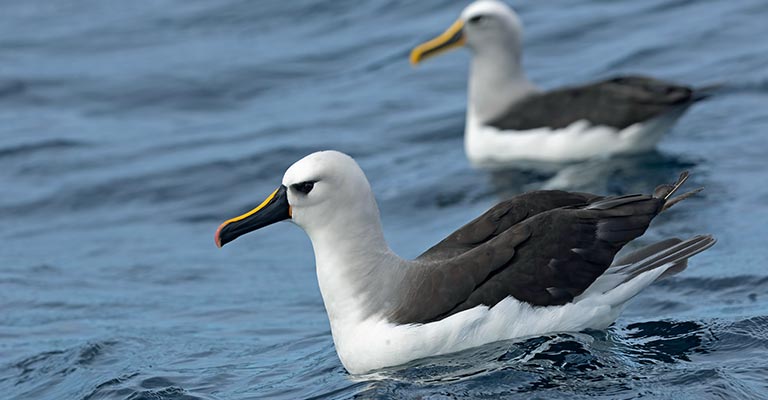
The Atlantic Yellow-nosed Albatross (Thalassarche chlororhynchos) is a distinctive seabird known for its unique physical characteristics, making it easily identifiable even amidst the vast expanse of the open ocean.
Here are eight key points to help identify this specific bird:
Size and Shape
The Atlantic Yellow-nosed Albatross is a large seabird with a wingspan averaging 200 to 240 centimeters (approximately 6.5 to 7.8 feet).
Its body is relatively slender with long, narrow wings, perfectly adapted for soaring effortlessly over long distances without expending much energy. The wings are sharply angled, giving the bird a distinctive silhouette in flight.
Plumage
This albatross species exhibits a striking contrast in its plumage. The upper parts, including the wings and back, are predominantly dark brown or blackish, while the underparts, including the belly and underwings, are white.
The head and neck are white, with a distinctive yellow stripe running along the top of the bill, giving rise to its name.
Bill and Facial Features
One of the most distinguishing features of the Atlantic Yellow-nosed Albatross is its bill. The bill is long, hooked, and pale yellow, with a prominent yellow ridge along the upper mandible.
The bright yellow coloration of the bill and the narrow yellow stripe extending from the bill to the eye make this bird easily recognizable, even from a distance.
Eye Color
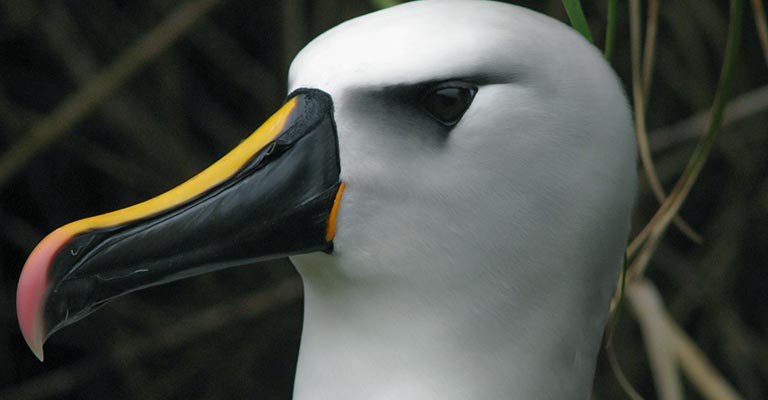
The eyes of the Atlantic Yellow-nosed Albatross are dark brown, contrasting with the yellow stripe extending from the bill to the eye. This coloration adds to the bird’s striking appearance and aids in its identification.
Tail
The tail of the Atlantic Yellow-nosed Albatross is relatively short and squared-off, with dark brown or blackish feathers. The tail lacks distinct patterns or markings, contributing to its uniform appearance.
Flight Pattern
When in flight, the Atlantic Yellow-nosed Albatross exhibits a distinctive soaring pattern, with long, sweeping glides interspersed with occasional flapping of its wings.
Its large wingspan and agile flight make it a graceful sight to behold as it navigates the winds above the ocean.
Behavior
These albatrosses are often observed following ships or scavenging for food near fishing vessels, where they opportunistically feed on discarded fish or offal.
The behavior of trailing ships can aid in their identification, especially for birdwatchers at sea.
Habitat and Range
The Atlantic Yellow-nosed Albatross primarily inhabits the Southern Ocean, particularly around sub-Antarctic islands such as Tristan da Cunha and Gough Island.
However, they may also range into the South Atlantic and occasionally venture into the North Atlantic. Their restricted range and association with specific oceanic regions further aid their identification.
The Atlantic Yellow-nosed Albatross can be readily identified by its large size, distinctive plumage, prominent yellow bill, and unique flying behavior, making it a captivating and easily recognizable species for bird enthusiasts and researchers.
Taxonomy of Atlantic Yellow-nosed Albatross
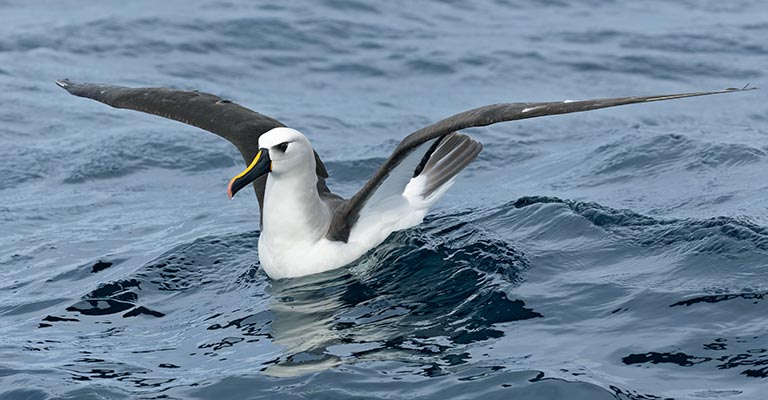
Below is the table detailing the taxonomy of the Atlantic Yellow-nosed Albatross:
| Taxonomic Rank | Classification |
| Domain | Eukaryota |
| Kingdom | Animalia |
| Phylum | Chordata |
| Class | Aves |
| Order | Phaethontiformes |
| Family | Diomedeidae |
| Genus | Thalassarche |
| Species | T. chlororhynchos |
The Atlantic Yellow-nosed Albatross belongs to the animal kingdom (Animalia), phylum chordate (Chordata), class Aves (birds), order Procellariiformes (tubenoses), family Diomedeidae (albatrosses), and genus Thalassarche.
Its scientific name is Thalassarche chlororhynchos. Within the albatross family, it is distinguished by its unique physical features, including a slender body, long wings, and distinctive yellow bill stripe.
Taxonomically, it is closely related to other albatross species, sharing similar ecological niches and behaviors, such as long-distance soaring over oceanic waters.
The taxonomy reflects its evolutionary relationships and provides a framework for understanding its biological characteristics and ecological role.
Typical Food of Atlantic Yellow-nosed Albatross
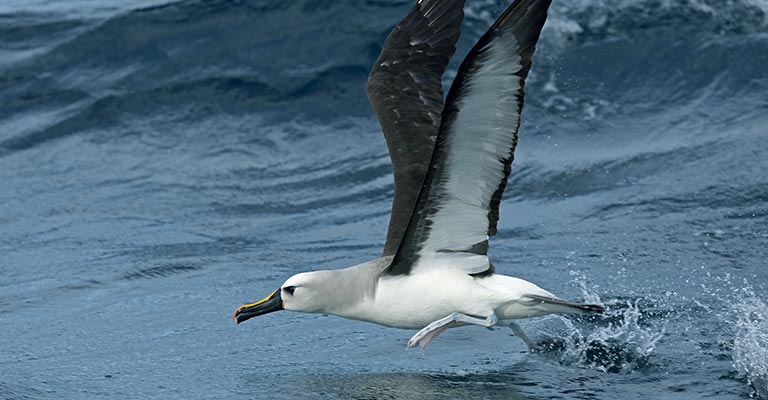
The Atlantic Yellow-nosed Albatross has a varied diet consisting primarily of marine organisms found in the open ocean. Their typical food habits include:
- Fish: They feed on various fish species, including small pelagic fish such as lanternfish, mackerel, and herring.
- Squid: Squid makes up a significant portion of their diet, with species like arrow squid and jumbo squid commonly consumed.
- Crustaceans: Albatrosses also prey on crustaceans such as krill, shrimp, and small crabs, which they catch near the ocean’s surface.
- Cephalopods: Besides squid, they may also consume other cephalopods like octopus and cuttlefish, which they capture while foraging at sea.
- Offal: When scavenging near fishing vessels, they opportunistically feed on offal and discarded fish, taking advantage of human activities in the marine environment.
These birds are highly adapted to foraging over vast expanses of the ocean, utilizing their keen eyesight and soaring ability to locate and capture prey efficiently. Their diet reflects their role as apex predators in the marine ecosystem.
Atlantic Yellow-nosed Albatross Life History
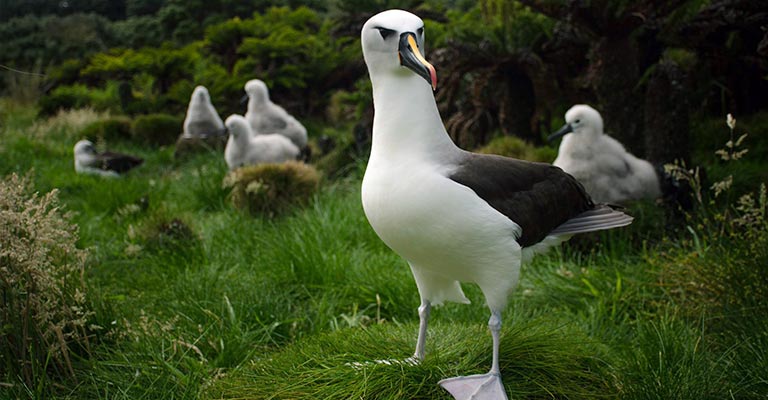
The Atlantic Yellow-nosed Albatross (Thalassarche chlororhynchos) is a magnificent seabird with a captivating life history deeply intertwined with the vast expanses of the Southern Ocean.
From its hunting habits to nesting behavior and conservation challenges, this species offers a fascinating insight into the complexities of marine avian life.
Hunting Habit
Atlantic Yellow-nosed Albatrosses are skilled hunters, adept at foraging over vast stretches of open ocean.
They utilize their keen eyesight to spot prey such as fish, squid, and crustaceans near the ocean’s surface. Often seen trailing fishing vessels, they scavenge for offal and discarded catch, demonstrating their opportunistic feeding behavior.
Habitat
These albatrosses primarily inhabit the Southern Ocean, frequenting sub-Antarctic islands like Tristan da Cunha and Gough Island.
They are highly adapted to an aquatic lifestyle, spending most of their lives at sea, soaring effortlessly over the waves in search of food.
Range Map
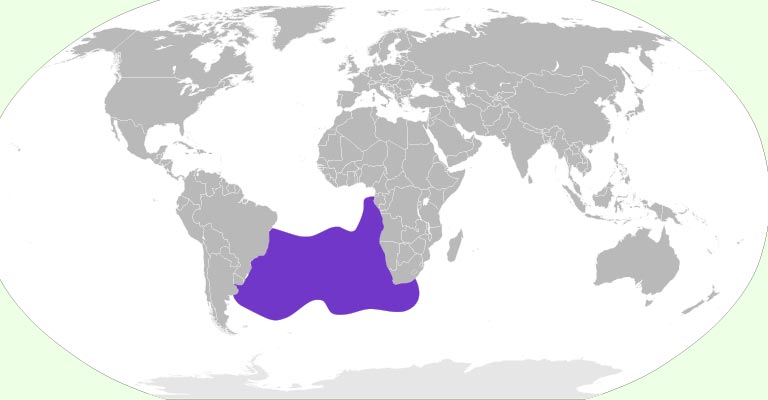
The range of the Atlantic Yellow-nosed Albatross spans across the Southern Ocean, with breeding colonies concentrated on remote island habitats.
A range map showcases their distribution, highlighting key breeding sites and foraging grounds throughout the Southern Hemisphere.
Nesting
Breeding colonies of Atlantic Yellow-nosed Albatrosses are found on isolated sub-Antarctic islands, constructing nests on cliffs or tussock grass slopes.
Males and females form long-term pair bonds and return to the same nesting sites year after year, engaging in elaborate courtship displays to reinforce their bond.
| Nesting Details | Facts |
| Clutch Size | Usually 1 egg |
| Number of Broods | Typically 1 per breeding season |
| Egg Length | Approximately 95-105 mm |
| Egg Width | Approximately 65-70 mm |
| Incubation Period | Around 70 days |
| Nestling Period | Approximately 120-140 days |
| Egg Description | Large, elliptical, creamy-white with a slight chalky texture |
| Nest Site | Both parents regurgitate food for the chick, primarily fish and squid. |
| Incubation | Shared by both parents, taking turns to keep the egg warm and protected |
| Chick Feeding | Both parents regurgitate food for the chick, primarily consisting of fish and squid |
| Fledging | Chicks fledge and become independent after around 4-5 months |
Breeding
Breeding occurs annually, with females laying a single egg in the nest. Both parents take turns incubating the egg and caring for the chick once it hatches.
The chick is fed a diet of regurgitated food, primarily consisting of fish and squid, until it fledges and becomes independent.
Diseases and Treatment
Like many seabird species, Atlantic Yellow-nosed Albatrosses are vulnerable to avian pox and aspergillosis.
Conservation efforts often include monitoring and treating affected individuals and providing medical care to mitigate the impacts of disease outbreaks on vulnerable populations.
Conservation
Conservation of Atlantic Yellow-nosed Albatrosses is critical due to threats such as overfishing, pollution, and habitat destruction.
Protected area designation, fisheries regulations, and international cooperation are essential for safeguarding their populations and ensuring long-term survival.
Efforts to reduce bycatch in fisheries, mitigate plastic pollution, and conserve their breeding habitats are vital to conservation strategies to preserve these majestic seabirds for future generations.
10 Fun Facts About Atlantic Yellow-nosed Albatross
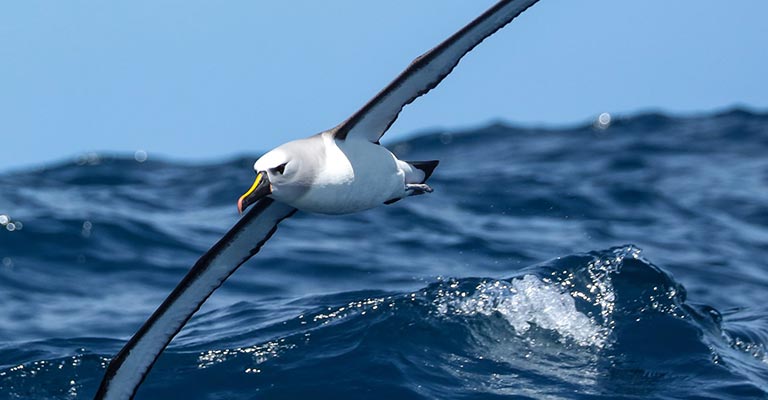
The Atlantic Yellow-nosed Albatross is a captivating seabird with various fascinating characteristics that make it a unique species within the avian world.
From its incredible lifespan to its remarkable navigational abilities, here are 10 fun facts about this magnificent bird:
Lifespan
Atlantic Yellow-nosed Albatrosses are known for their longevity, with some individuals living up to 50 years or more in the wild.
Wingspan
These birds possess an impressive wingspan, measuring between 200 to 240 centimeters (approximately 6.5 to 7.8 feet), allowing them to glide effortlessly over vast expanses of ocean.
Flying Skills
Atlantic Yellow-nosed Albatrosses are highly skilled flyers, capable of traveling thousands of kilometers without flapping their wings, relying instead on dynamic soaring and gliding techniques.
Monogamous Bond
They form long-term monogamous pair bonds, with mates returning to the same nesting sites year after year, engaging in elaborate courtship rituals to reinforce their bond.
Navigational Abilities
Despite spending the majority of their lives at sea, Atlantic Yellow-nosed Albatrosses possess remarkable navigational abilities, able to navigate back to their nesting colonies with pinpoint accuracy.
Dietary Habits
They have a varied diet, feeding primarily on fish, squid, and crustaceans, often scavenging for food near fishing vessels or foraging over the open ocean.
Breeding Colonies
Breeding colonies of Atlantic Yellow-nosed Albatrosses are found on remote sub-Antarctic islands, constructing nests on cliffs or tussock grass slopes.
Parental Care
Both parents take turns incubating the egg and caring for the chick once it hatches, with chicks fledging and becoming independent after around 4-5 months.
Conservation Status
Despite their remarkable adaptability, Atlantic Yellow-nosed Albatross populations face threats from human activities such as overfishing, pollution, and habitat destruction.
International Protection
They are protected under international agreements such as the Agreement on the Conservation of Albatrosses and Petrels (ACAP), which aims to mitigate threats to albatross populations and ensure their long-term survival.
These fun facts offer a glimpse into the unique characteristics and behaviors of the Atlantic Yellow-nosed Albatross, showcasing why it is a species worthy of admiration and conservation efforts.
Wrapping Up
The Atlantic Yellow-nosed Albatross emerges as a remarkable ambassador of the open ocean, captivating us with its longevity, aerial prowess, and steadfast commitment to its mate and nesting sites.
Despite facing numerous challenges human activities pose, these majestic seabirds inspire awe and admiration.
As we delve deeper into their world, it becomes evident that their conservation is not just about protecting a species but safeguarding the delicate balance of marine ecosystems they inhabit.
By concerted efforts to mitigate threats and preserve their habitats, we can ensure that future generations will also have the privilege of marveling at the beauty and resilience of the Atlantic Yellow-nosed Albatross.